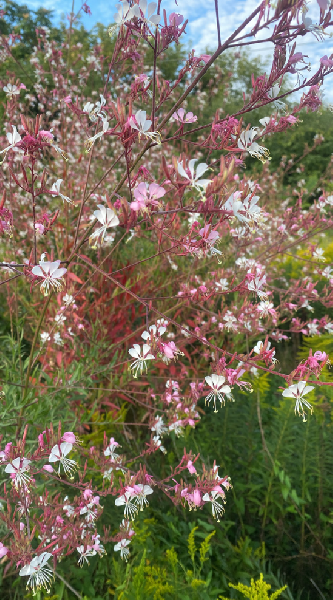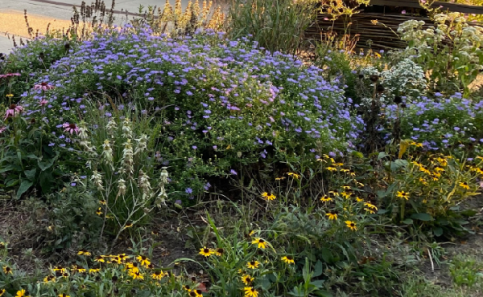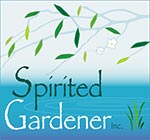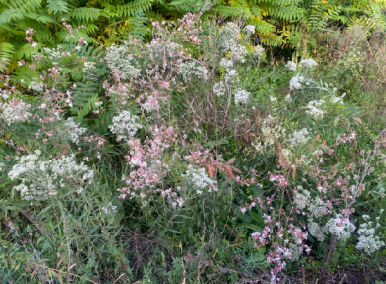Bursting with Color: Why Native Annuals Deserve a Spot in Your Garden
 Many gardeners associate native plants with perennials – the steadfast beauties that return year after year. And while perennials form the backbone of a thriving native ecosystem, don't overlook the vibrant potential of native annuals! These short-lived plants may only last one growing season, but they bring powerful ecological benefits, bursts of seasonal beauty, and fresh opportunities to support pollinators.
Many gardeners associate native plants with perennials – the steadfast beauties that return year after year. And while perennials form the backbone of a thriving native ecosystem, don't overlook the vibrant potential of native annuals! These short-lived plants may only last one growing season, but they bring powerful ecological benefits, bursts of seasonal beauty, and fresh opportunities to support pollinators.Challenging the Misconception:
There's a common misconception that native gardening is solely about perennials. This likely stems from the focus on establishing long-term, self-sustaining ecosystems. However, nature itself utilizes annuals extensively! Think of fields of wildflowers that bloom and set seed in a single season. Native annuals and (plants that take 2 years to complete their full life cycle) play crucial roles in these natural cycles, and they can bring similar benefits to your home garden.
The Benefits of Incorporating Native Annuals:
- Instant Color and Impact: Native annuals provide immediate visual appeal, filling in bare spots and adding pops of color while your slower-growing perennials establish themselves. This can be especially rewarding in the first few years of a new garden.
- Attracting Pollinators and Beneficial Insects: Many native annuals are nectar and pollen powerhouses, attracting a wide array of bees, butterflies, and other beneficial insects. Some may even serve as host plants for specific butterfly or moth species.
- Extending the Bloom Season: By strategically incorporating native annuals with different bloom times, you can extend the flowering period in your garden, providing a continuous source of nectar and pollen for pollinators throughout the growing season.
- Filling Ecological Niches: In nature, annuals often thrive in disturbed areas or gaps in vegetation. In your garden, they can play a similar role, prevent weed establishment and utilizing resources that might otherwise go unused.
- Flexibility and Experimentation: Annuals offer a chance to experiment with different colors and textures in your garden each year without a long-term commitment. You can try out new species and see what thrives in your specific conditions.
- Seed Production for Future Generations: Many native annuals readily self-seed, potentially providing you with plants in subsequent years and contributing to a more dynamic and naturalistic garden.
- Partridge Pea (Chamaecrista fasciculata): A cheerful yellow bloomer that attracts bees and is a larval host for several butterfly species. It's also drought-tolerant and thrives in sunny spots.
- Plains Coreopsis (Coreopsis tinctoria): Bright yellow flowers with reddish centers that bloom profusely and attract pollinators. It's adaptable to various soil types and moisture levels.
- Spotted Jewelweed (Impatiens capensis): Orange, uniquely shaped flowers that attract hummingbirds and are found in moist, shady to part-shade areas. Its seed pods pop open when touched, adding a fun element.
- Tickseed Sunflower (Bidens aristosa): Yellow, daisy-like flowers that bloom in late summer and fall, providing a valuable late-season nectar source for pollinators.
Biennial Guara (Guara biennis)- Biennial pictured to the left and above in a restoration area in Skokie near Emily Oaks Nature Center and that same plant purchasable for your summer annual pots!
The key to successfully incorporating native annuals is to think strategically about placement and timing:
- Fill in the Gaps: Plant annuals in the spaces between newly planted or slower-growing perennials. This will provide immediate color and help suppress weeds while your perennials mature.
- Successional Planting: Choose annuals that bloom at different times than your perennials to extend the overall bloom season in your garden. For example, plant early-blooming annuals alongside later-blooming perennials.
- Consider Height and Texture: Use taller annuals as temporary backdrops or vertical accents among shorter perennials. Mix different leaf textures for added visual interest.
- Embrace Self-Seeding (with caution): Allow some annuals to self-seed if you enjoy a more naturalistic look. However, be mindful of potentially aggressive self-seeders and manage their spread as needed.
- Don't Be Afraid to Experiment: Try different native annuals each year to see what performs well in your garden and attracts the most pollinators.
___________________________________________________________________________________________________________________
Eco(Fun) Fact: Don't Judge a Season by Its Name
When we think of summer, we often picture a big, beautiful climax of blooms. But for many native pollinators, the show isn't over when August ends. Instead, late summer and early fall are a crucial "last call" for food. While many plants are winding down, native late bloomers are just getting started, providing a critical lifeline for insects as they prepare for a long winter or a big migration. It's a final feast that gives them the energy they need to survive. So as you tend to your garden in the coming weeks, look for these hardworking late-season superstars. Great Blue Lobelia (Lobelia siphilitica) and Cardinal Flowers (Lobelia cardinalis) stand tall and vibrant, offering a vital nectar source when other options are scarce. And the cheerful daisy-like blooms of Aromatic Asters (Symphyotrichum oblongifolium) are a buzzing hotspot for bees and butterflies. By planting these natives, you're not just adding beauty to your yard; you're providing an essential pit stop for our local ecosystem and ensuring your garden is a food source from the first days of spring until the first frost of winter.
So as you tend to your garden in the coming weeks, look for these hardworking late-season superstars. Great Blue Lobelia (Lobelia siphilitica) and Cardinal Flowers (Lobelia cardinalis) stand tall and vibrant, offering a vital nectar source when other options are scarce. And the cheerful daisy-like blooms of Aromatic Asters (Symphyotrichum oblongifolium) are a buzzing hotspot for bees and butterflies. By planting these natives, you're not just adding beauty to your yard; you're providing an essential pit stop for our local ecosystem and ensuring your garden is a food source from the first days of spring until the first frost of winter.




